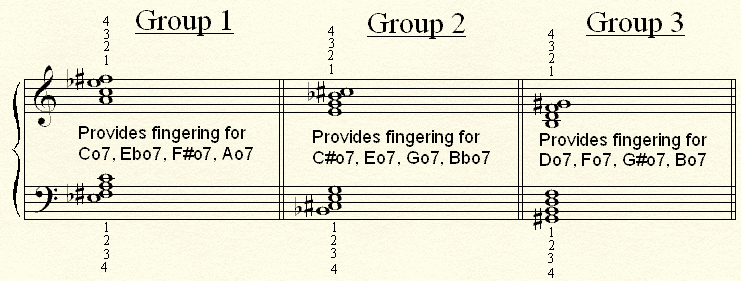Piano Arpeggios
Home » Piano Technique » Piano Arpeggios
In this piano lesson we're going to talk about "broken chords". When you play an Arpeggio you basically "break" the chord by playing one note at a time. Each chord can contain 3 notes, 4 notes or even more.
Practicing these broken chords is very important since they appear often in music. Practice them and you will improve your piano technique. You can find them in different music genres such as Jazz, Pop, Rock and more...
We'll start with learning the piano fingerings of three tone chords
(Major and minor chords). We'll end up with a few handy exercises.
Ready? Let's go!
Three Tone Chords (Major and Minor)
When playing three tone chords the fingering is based on the natural shape of the hand and the way it fits on the keyboard most easily. So we basically try to make our life as easy as possible without changing our hand position if not necessary.
There are two fingering groups for three tone chords played as arpeggios:
1. First note is a white key - (Starting with C,D,E,F,G,A,B)
R.H: 123-123-(5).
L.H: (5)-321-321.

2. First note is a black key-(Starting with Db, Eb in major only, F# in minor only, Ab).
RH: 2-124-124.
LH: 214-214-2.

Notice that in both cases the thumb will always be placed on the white notes - that's very convenient even for the unskilled hand.
So we're basically trying to avoid placing the thumb on a black key.
There are few exceptions to the rules above:
1. When playing an F# major and Eb minor chord we'll apply the same fingering we use when playing a chord with only white keys.
2. The fingering for a Bb major chord in the left hand will be: 321-321-3.
3. The fingering for a Bb minor chord will be 231-231-2 in the right hand and 321-321-3 in the left hand.
|
Click here if you haven't signed to Piano Playground, our free E-zine yet make sure you do that in order to get the username and password codes for the Piano Arpeggios Exercises I provide here under. |
Click here to see the fingerings all major chords.
Click here to see the fingerings of all minor chords.
Four Tone Chords - Dominant 7th
When playing four tone chords we still apply the rules we've learn in the three tone chords.
1. First note is a white key - (C7, D7, E7, F7, G7, A7, and B7)
RH: 1234-1234-(5)
L.H. (5)-4321-4321
LH: (5)-4321-4321

When we descend we keep the same fingering order. You can see the order of the ascending scale in the example above. However if you read this exercise from right to left you'll be playing the order of the descending scale.
2. First note is a black key - (Db7, Eb7, and Ab7)
RH: 4-1234-1234
LH: 21-4321-432

Exceptions
Click here to see the fingering of all dominant V7.
F#7:
RH:234-1234-12
LH:4321-4321-4
Bb7:
RH: 4-1234-1234
LH: 321-4321-43
Here are some exercises that will help you to master the Arpeggios. Play these exercises both in major and minor chords through all twelve keys.
Exercise 4 |
Exercise 5 |
Diminished 7 Arpeggios
Memorizing the fingerings of the diminished 7 is much easier, since there are actually only 3 different diminished 7th chords. Ao7 for example, contains the same notes as Co7, Ebo7 or F#o7. (The pitches are - A, C, Eb, F#).
The only thing you have to be familiar with is the hand position but the same fingering apply for all the chord members in the same group. Every arpeggio in that group will have the same fingering, only it will start from a different note.
Here are the three diminished 7 chord groups, and their correct hands' position:

Let's take the Ao7 arpeggio for example:

And now the Co7:

See? the fingering is exactly the same! We simply start from a different note.
- (Notice that the 5th finger is sometimes placed at the beginning or at the ending of the broken chord).

Now you have an idea on how to play arpeggios on the piano. The problem is that you have to play all these exercises smoothly while keeping the independence, coordination of your fingers while gaining each times a faster finger speed. To learn to this you must check out the Hannon Finger Exercises Piano Course.
In this DVD, the exercises are demonstrated by an accomplished jazz instructor, James Wrubel, and broken down step-by-step in VIDEO format so that anyone with a dvd player or computer and 1 hour to spare can start using them right away.
I highly recommend you check out a sample of the first exercise on their website. Just that one sample exercise can dramatically improve your speed and precision. Click here to check out the Hannon Finger Exercises Piano Course Now!














